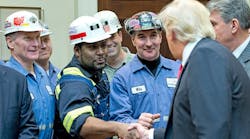President Donald Trump is taking bold steps to boost the declining coal industry, but the moves won’t restore many of the jobs lost by coal miners in West Virginia, Ohio and Pennsylvania who helped the president win his job in the White House.
Trump will sign an order Tuesday to dismantle the very foundations of his predecessor’s government-wide effort to combat climate change, according to details provided to Bloomberg News. It will resume the sale of coal from federal land, lift carbon dioxide limits on power plants and end Obama-era mandates that agencies consider global warming in a broad range of decisions.
“A lot of people are going to be put back to work, a lot of coal miners are going back to work,” Trump told a rally in Louisville, Kentucky last week, previewing the announcement. “The miners are coming back.”
Yet, as sweeping as the order is, it won’t immediately boost demand for coal, which is facing stiff competition from cheaper natural gas and a boom in wind and solar power. It comes as mining employment has been falling for decades as dozers and conveyor belts replaced humans with pickaxes and mules.
“The reality is that the demand for coal has been decreasing for a while and it’s going to continue to decrease,” Sheldon Stone, a partner and head of restructuring at the investment banking firm Amherst Partners, LLC, said in an interview. “Even by doing this you are not going to be bringing mining jobs back.”
The order makes good on promises Trump made during his presidential campaign to overturn the environmental policies of President Barack Obama.
Trump rode a wave of frustration from disenfranchised voters, and the coal miner is a potent symbol of the displaced U.S. worker left behind by a shifting global economy and the politics of climate change.
He donned a miner’s helmet during a campaign swing through West Virginia and referred to his support of coal miners and steelworkers to convey his allegiance to working-class voters. They rallied behind him, and he won 68% of the vote in West Virginia, a once reliably Democratic state. He also improbably carried Pennsylvania, once the center of the coal industry.
Patrick Hickey, a political science professor at West Virginia University, says coal shares the same kind of nostalgia as manufacturing, tied to the belief of some voters that their lives were much better economically 20 to 30 years ago. "It becomes a powerful political rhetorical appeal to hearken back," he said, "because even if you’re not directly connected to the industry, you may know family members or relatives or ancestors who were."
In some parts of the U.S., "it’s political suicide to tell citizens the truth about coal," Hickey said.
The White House’s chief target on Tuesday is the Clean Power Plan, a policy that was the cornerstone of Obama’s policies to address climate change. The rule, which was put on hold by the Supreme Court, aimed to slash greenhouse gas emissions from electricity by 32% by 2030 compared to 2005 levels. It would have accomplished this in large part by pushing generators to curb their use of coal--which emits the most carbon for each unit of energy created--and replace it with cleaner natural gas, wind or solar power.
Trump will also direct EPA head Scott Pruitt to review carbon dioxide requirements for building any new power plants--rules that critics said would make it too expensive to build a new coal plant in the U.S.
It will take at least a year of bureaucratic work for the Trump administration to unwind the Clean Power Plan, with the EPA forced to justify its policy shift and seek out public comment. And the action will inevitably be challenged in court by the same environmentalists fighting to defend the rule now.
But even without the Clean Power Plan in force, coal’s use to generate electricity has been in decline as a result of earlier pollution regulations and stiffer competition from other fuels.
Obama’s rules would have destroyed more coal-based electricity generation if it went into force, but stopping the slide is different from bringing back plants that have already shuttered or announced their closure, according to Jason Bordoff, who served in Obama’s White House and is the director of Columbia University’s Center on Global Energy Policy.
"Scrapping the Clean Power Plan may slow the decline of coal--but it’s not bringing coal back," Bordoff said. "The primary drivers of coal’s decline have been domestically weak electricity demand, cheap natural gas and falling renewable cost."
Murray Energy
One of Trump’s most vocal supporters in the industry agrees.
"People are going to freeze in the dark because of the destruction of the reliable electric power grid under Obama and the Democrats," Robert Murray, the president of mining company Murray Energy Corp., said in an interview. "Mr. Trump is doing the right things."
Murray, who plans to be with Trump when he signs the executive order, said he has no immediate plans to reopen mines or hire miners after the executive order is signed.
"It’s not going to bring back jobs right away," he said. "We have to stop the destruction before we can go forward in the coal industry."
Utilities say they are moving ahead with plans to shift toward solar, wind and natural gas, even without the prod from the EPA.
"We will continue our transition to more natural gas and renewables as we balance out our generation portfolio and provide cleaner energy," said Tammy Rideout, a spokeswoman for Columbus, Ohio-based American Electric Power Co., which owns about 26,000 megawatts of generating capacity, about half of which is coal-fueled.
And boosting demand for coal is not the same as boosting coal-mining employment.
The image of miners toiling underground is increasingly antiquated, as companies use automated tools to extract coal from giant seams in the Powder River Basin in Wyoming and Montana. There, electric shovels are able to claw 400 tons worth of coal at a single time from open pits, and load them up onto rail cars bound for plants as far away as Georgia.
As a result, total U.S. coal employment plunged to 53,000 last year; in the 1940s, West Virginia alone was home to 126,000 miners.
“I don’t see this creating a big change for the industry, especially for coal-mining jobs,” said Thom Kay, a legislative representative for the environmental group Appalachian Voices.
Still, there is one area of optimism.
Demand for metallurgic coal, used in steelmaking, is up and that’s led to the reopening of a few Appalachian mines. Ramaco Resources Inc. opened its Elk Creek mine in West Virginia in December and plans to open two more this year. Corsa Coal Corp.’s starting a new operation in Pennsylvania as early as May.
Hal Quinn, president of the National Mining Association president, said the Clean Power Plan "served the interests of political activists, not the American people."
“The president’s actions help to restore common sense priorities and the important balance between costs and benefits that have been missing from federal regulatory policies.”



